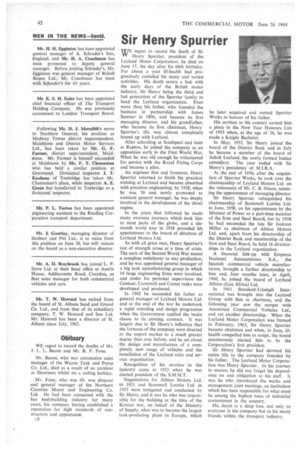Sir Henry Spurrier
Page 44

If you've noticed an error in this article please click here to report it so we can fix it.
VVE regret to record the death of Sir Henry Spurrier, president of the Leyland Motor Corporation; he died on June 17, the day after his 66th birthday. For about a year ill-health had progressively curtailed his many and varied activities. His death severs a link with the early days of the British motor industry, Sir Henry being the third and last generation of the Spurrier family to head the Leyland organization. Even more than his father, who founded the business in partnership with James Sumner in 1896, and became its first managing director, and his grandfather, who became its first chairman, Henry Spurrier's fife was almost completely bound up with Leyland.
After schooling at Southport and later at Repton, he joined the company as an apprentice early in the First World War. When he was old enough he volunteered for service with the Royal Flying Corps and became a pilot.
An engineer first and foremost, Henry Spurrier returned to finish his practical training at Leyland and became absorbed with precision engineering; by 1928, when he was 30 and newly promoted to assistant general manager, he was deeply involved in the development of the diesel engine.
In the years that followed he made many overseas journeys which took him to most parts of the globe, and a sixmonth world tour in 1938 preceded his appointment to the board of directors of Leyland Motors Ltd.
As with all great men, Henry Spurrier's test of strength arose at a time of crisis. The start of the Second World War meant a complete switchover to war production, and he was appointed general manager of a big tank manufacturing group in which 14 large engineering firms were involved, and under his personal supervision the Centaur, Cromwell and Comet tanks were developed and produced.
In 1942 he succeeded his father as general manager of Leyland Motors Ltd. and at the end of the war he undertook a rapid retooling and design programme when the Government applied the brake clause to its existing contract. It was largely due to Sir Henry's influence that the fortune's of the company were directed to the export market to a much greater degree than ever before, and he set about the design and manufacture of a completely new range of vehicles and the installation of the Leyland sales and service organization.
Recognition of his services to the industry came in 1952 when he was elected president of the S.M.M.T.
Negotiations for Albion Motors Ltd. in 1951 and Scammell Lorries Ltd. in 1955 were instigated and conducted by Sir Henry, and it was he who was responsible for the building at the time of the Korean war, on behalf of the Ministry of Supply, what was to become the largest tank-producing plant in Europe, which
he later acquired and named Spurrier Works in honour of his father.
His services to his country earned him a place in the New Year Honours List of 1955 when, at the age of 56, he was made a Knight Bachelor.
In May, 1955, Sir Henry joined the board of the District Bank and in July he became a member of the board of Ashok Leyland, the newly formed Indian subsidiary. The year ended with Sir Henry's presidency of M.I.R.A.
At the end of 1956, after the acquisition of Spurrier Works, he took over the chairmanship of Leyland Motors Ltd. on the retirement of 114r. C. B. Nixon, retaining the appointment of managing director.
Sir Henry Spurrier relinquished his chairmanship of Scammell Lorries Ltd. in June, 1958, on his appointment by the Minister of Power as a part-time member of the Iron and Steel Board, but by 1959 he had succeeded the late Sir Jackson Millar as chairman of Albion Motors Ltd. and, apart from his directorship of the District Bank and membership of the Iron and Steel Board, he held 16 directorships in the Leyland organization.
A financial link-up with Empresa Nacional Autocamiones S.A., the Spanish commercial vehicle manufacturers, brought a further directorship to him and, four months later, in April, 1960, he joined the board of Leyland Albion (East Africa) Ltd.
In 1961 Standard-Triumph International was brought into the Leyland Group with him as chairman, and the following year saw the merger with Associated Commercial Vehicles Ltd., and yet another directorship. When the Leyland Motor Corporation was formed in February, 1963, Sir Henry Spurrier became chairman and when, in June, illhealth compelled him to resign, the board unanimously elected him to be the Corporation's first president.
Sir Henry Spurrier had devoted his entire life to the company founded by his father. The Leyland Motor Corporation was Henry Spurrier. In his journey to success he did not forget his dependence on and obligation to his staff. It was he who introduced the works and management joint meetings, an institution which has been responsible for what must be among the highest rates of industrial contentment in the country.
His death is a deep loss, not only to everyone in the company but to his many friends within the transport industry.




























































































































